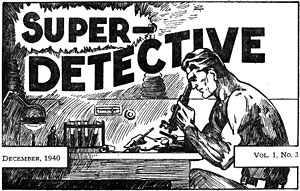 For those not familiar, Jim Anthony was a kind-of Doc Savage “clone” published by Trojan/Culture Publications in the early 1940s, a publisher of the “spicy” pulps, sort-of soft porn pulp magazines. Strangely enough, it was owned by the same guy who owned DC Comics, which may explain why the title of his magazine, Super-Detective looks like the title of Superman Comics. I had previously mentioned him in a posting about other pulp-era Doc “clones.”
For those not familiar, Jim Anthony was a kind-of Doc Savage “clone” published by Trojan/Culture Publications in the early 1940s, a publisher of the “spicy” pulps, sort-of soft porn pulp magazines. Strangely enough, it was owned by the same guy who owned DC Comics, which may explain why the title of his magazine, Super-Detective looks like the title of Superman Comics. I had previously mentioned him in a posting about other pulp-era Doc “clones.”
Myself, I had never heard of him when I was first getting into pulp heroes. It was only after I got back into the current New Pulp movement a few years back that I heard about this character and finally got to read a few of his stories.
Jim Anthony was “half Irish, half Indian, and all-American.” More emotional than Doc, Anthony was a physical and mental marvel. He had a penthouse in the Waldorf-Anthony Hotel he owned, had a secret mansion in the Catskills called “The Tepee,” another resort in an oasis in the American Southwest called “The Pueblo.” He was assisted by a small group of people include Tom Gentry, pilot and right-hand man; Mephito, his shaman grandfather; his butler; and Dolores Colquitte, the daughter of a U.S. senator and his fiancé.
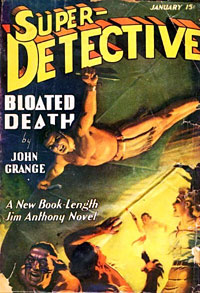 His series ran for 24 issues of Super-Detective magazine in 1940-43. For the first 10 or so issues, he was “Super Jim Anthony” (as most refer to him), where he fought against science-fictional menaces. After that, he was sort of “de-powered” and lost most of his aides except for Tom. He turned into more of a hard-boiled detective. He would soon be written by the authors of Trojan’s Dan Turner, Hollywood Detective: R.L. Bellem and W.T. Ballard for the last 10 issues. At the beginning he was written by Victor Rousseau. It’s known he wrote the first three and perhaps the rest of the novels before the others took over.
His series ran for 24 issues of Super-Detective magazine in 1940-43. For the first 10 or so issues, he was “Super Jim Anthony” (as most refer to him), where he fought against science-fictional menaces. After that, he was sort of “de-powered” and lost most of his aides except for Tom. He turned into more of a hard-boiled detective. He would soon be written by the authors of Trojan’s Dan Turner, Hollywood Detective: R.L. Bellem and W.T. Ballard for the last 10 issues. At the beginning he was written by Victor Rousseau. It’s known he wrote the first three and perhaps the rest of the novels before the others took over.
Altus Press is working on a complete reprint series of Jim Anthony. So far, they’ve put out one volume. That volume reprints the first three novels, in which Jim goes up against Rado Ruric, a foreign villain. The stories are “Dealer in Death,” “Legion of Robots,” and “Madame Murder.”
In the first novel, Rado is fomenting trouble for the U.S. at the behest of a munitions owner who hopes to make billions selling munitions to the U.S. We learn this is actually the second time Anthony has gone up against him, as Anthony had previous dealings with Rado in Tibet (this is hinted in the next two stories, but we don’t learn more about it).
In the next novel, Rado is on his own. He has duped some Indians (from India) to help him. He creates a mechanical sea serpent, and gets a drug that turns people into “robots,” basically super-strong and easily-controlled zombies. He menaces The Pueblo, but is again defeated (but escapes).
In the final novel, Rado is now behind a world-wide extortion ring (kind of a letdown from the previous novels in scope). Anthony figures things out and defeats Rado, who is killed in an explosion.
Of the three stories I found the first two more interesting then the third. I look forward to seeing the next volume, as few of these stories have been reprinted before.
As Jim Anthony is in the public domain, others have created new stories with him. Airship 27 has put out three volumes of new Jim Anthony stories.
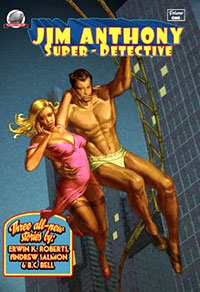 The first volume from Airship 27 has three stories by Andrew Salmon, Erwin K. Roberts and B.C. Bell. The second volume, called “The Hunters,” is actually a two-part novel by Joshua Reynolds and Micah Harris. In it, Jim teams up with (and against) Count Zaroff, the villian of the novel/film The Most Dangerous Game, fighting yetis and later deals with King Kong.
The first volume from Airship 27 has three stories by Andrew Salmon, Erwin K. Roberts and B.C. Bell. The second volume, called “The Hunters,” is actually a two-part novel by Joshua Reynolds and Micah Harris. In it, Jim teams up with (and against) Count Zaroff, the villian of the novel/film The Most Dangerous Game, fighting yetis and later deals with King Kong.
The third volume is actually a novel by Reynolds, “The Mark of Terror.” The story is set before the published stories, which I don’t have a problem with (but felt it was set too far before). We have Tom and his butler. His grandfather is mentioned, but does not appear (which I felt he should). He is not involved with Dolores (though they run into each other). He is instead involved with a reporter from a rival newspaper (Anthony also owns a paper). Mention is made of him serving in WWI, but felt that was wrong as it makes him too old.
Here he is dealing with an ancient cult and a coalition of business men. We get hints of other previous cases, which is a nice setup. Also comments are made that tie into other characters. Some may get them, some not.
Joshua Reynolds seems to be taking the lead in writing new Jim Anthony stories. He has written a few that have appeared in volumes of Black Coat Press‘s “Tales of the Shadowmen,” mostly set in the post-WWII period. And he wrote a story in the second “Black Bat Mysteries” from Airship 27 in which Jim Anthony appeared. Set in 1940, it is said that Anthony is retired. That makes no sense, as his original stories were published from 1940-43. Unless the author is trying to say his published adventures happened much earlier then that. Also, there was a scene with Anthony kind of “passing the torch” to the Black Bat, as if the Black Bat represented the new generation of such heroes as compared to Anthony. But the thing is, both the Bat and Anthony are part of the “third wave” of pulp heroes (using a term Will Murray uses). The Bat actually started a year before Anthony. So didn’t quite make sense to me.
So there you have him, Jim Anthony, Super-Detective. An interesting and unique character in his own right, tho apparently inspired by Doc Savage. Check him out, either old and new stories (or better yet, both).

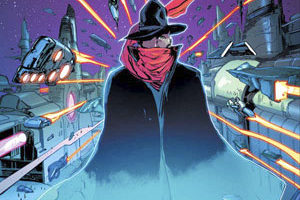
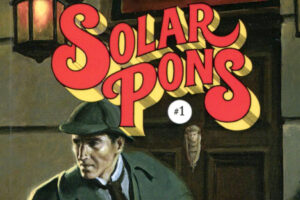
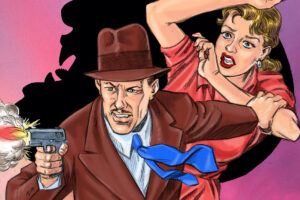
Your comments